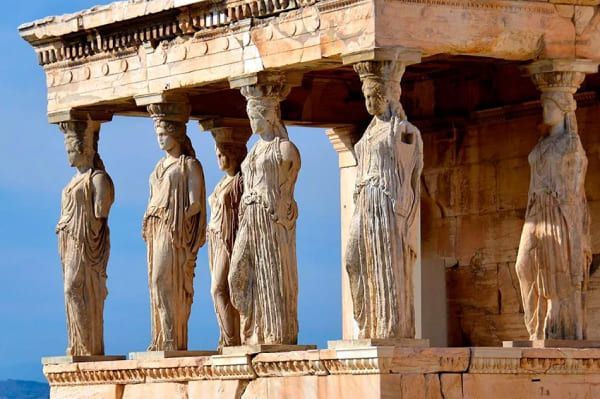Find information about the main attractions in the Acropolis
On the northern side of Athens’ Acropolis stands the ancient Greek temple known as the Erechtheion. It is regarded as one of the most important specimens of ancient Greek architecture and was constructed between 421 and 406 BC, during the Golden Age of Athens. The Athens patron goddess Athena Polias and other mythical characters were worshiped in the temple.
On the northern side of the Acropolis in Athens, Greece, there is a historical temple called the Erechtheion. Its construction was overseen by the architect Mnesicles between 421 and 407 BC. The temple is named after the mythical king Erechtheus, who was believed to have been buried on the site. The building was also dedicated to Athena Polias, the goddess of the city, and Poseidon, who was said to have created a saltwater spring by striking his trident on the site.
The temple’s history is closely tied to the political and cultural developments of ancient Athens. It was built during the Golden Age of Athens, a time of great prosperity and artistic achievement. The building was commissioned by the Athenian statesman Pericles, who sought to create a grand temple that would showcase the cultural and artistic achievements of Athens. The Erechtheion remains an important cultural landmark in Athens today, attracting visitors from around the world who come to admire its innovative design and rich cultural heritage.

The architecture of the Erechtheion is unique and innovative, reflecting the complex mythological and historical associations of the site. The temple is designed in the Ionic style, but also incorporates elements of the Doric and Corinthian orders, creating a rich and varied visual effect. The building is divided into two main sections, the eastern section and the western section, which are separated by a large central hall.
The interior of the Erechtheion is divided into two main sections, the eastern section, and the Western section. The central hall, which separates the two sections, is known as the Hekatompedon (meaning “hundred-foot hall”) and features six Ionic columns on either side.
The eastern section of the temple housed the cult statue of Athena Polias, the city’s patron goddess. The statue was believed to be an ancient wooden xoanon, or cult image, which was said to have fallen from the sky during the reign of Erechtheus. The room also contained a large statue of Poseidon, as well as a well that was said to have been created by Poseidon’s trident.
The western section of the temple housed the cult of Erechtheus, a mythical king of Athens. The room contained a large statue of the king, as well as the “olive tree of Athena”, which was said to have been planted by Athena herself. The room also featured a large opening in the floor, which revealed an underground chamber known as the Kekropion, where the remains of the first king of Athens, Kekrops, were said to be buried.
The Acropolis ticket grants visitors access to the archaeological site of the Acropolis and its slopes, including the Parthenon, the Theater…
The Parthenon is an iconic symbol of ancient Greek civilization and a masterpiece of classi…
On Athens’ Acropolis, there is a stunning and well-known ancient Greek temple called…
